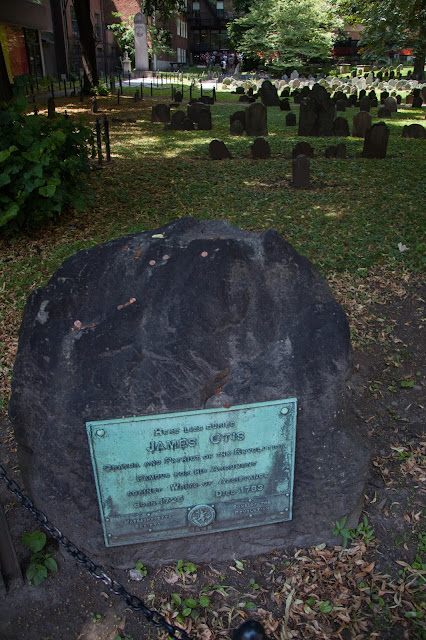From the park, we walked over to the Granary Burying Ground. This burying ground is the city of Boston's third-oldest cemetery, founded in 1660 and located on Tremont Street. It is the final resting place for many notable Revolutionary War-era patriots, including Paul Revere, the five victims of the Boston Massacre, and three signers of the Declaration of Independence: Samuel Adams, John Hancock, and Robert Treat Paine. The cemetery has 2,345 grave-markers, but historians estimate that as many as 5,000 people are buried in it.
It took a little bit of searching, but we were able to find most of the notable people buried here, starting with Paul Revere.
The hardest one to find was Mary "Mother" Goose. Her headstone is small and extremely weather worn and I'm pretty sure I read every headstone before I found hers. There is some debate about whether this is the burial site of the original Mother Goose or not, either way, it was still fun to see.
From the Granary Burying Ground, we walked over to the Old South Meeting House.
The Old South Meeting House has been an important gathering place for nearly three centuries. Renowned for the protest meetings held there before the American Revolution when the building was termed a mouth-house, this National Historic Landmark has long served as a platform for the free expression of ideas. It is most well known for being the organizing point for the Boston Tea Party on December 16, 1773. Five thousand or more colonists gathered at the Meeting House that night, it the largest building in Boston at the time.
Our last stop of the day was at iconic Old State House. The juxtaposition of old vs. new with this building being right in the center of so many office buildings is so fascinating to see. Built in 1713, the Old State House was a seat of British power and site of the Boston Massacre. It became a point of origin for vital debates about self-government that sparked the Revolution.
The Boston Massacre occurred in the square in front of the Town House. It was some of the first bloodshed in the years before the Revolution, and a dramatic escalation in the disputes between the British and colonists. In 1768, armed troops were brought to Boston to help control colonial resistance. Nearly 2,000 Regulars arrived in the town of 15,000 people over the next 2 years. The soldiers and the colonists had an uneasy relationship from the beginning, which deteriorated until violent conflict was almost inevitable. The event itself was not really a massacre but an instance of mob violence due to tension between colonists and soldiers, tragically five Boston residents were killed in the scuffle. The event was used by patriots to rally other colonists to their cause against British rule and became an iconic, if misunderstood event.
The Declaration of Independence was read for the first time in Boston from the balcony of the Old State House on July 18, 1776. Abigail Adams was in the crowd that day, and wrote to John (still in Philadelphia) about the event. The emotional scene on this balcony was not the first time Bostonians gathered here for important news, nor the last. The accession of King George III was proclaimed from here in 1761. Just 19 years later, the election of John Hancock as the first governor of the new state of Massachusetts was announced from this balcony. Years later in the 20th century, Queen Elizabeth II visited this same balcony and greeted the people of Boston.
There were several fun and informative exhibits for kids around the museum.
I saw these tea bricks in the gift store and thought they were so beautiful. Plus I found it so interesting that it was tea bricks that are thrown overboard in the Boston Tea Party, I always assumed it was tea bags. I bought one as a unique souvenir of the American Revolution.
This accurately describes how we would feel after spending the day exploring the Freedom Trail. As it was July, the days were really hot, and we did a lot of walking each day. But that is how we got to see so much of each of the cities we visited!
Dinner that night was so fun and special, we met up with my cousin Julia for an elegant dinner at the Parker House!
Julia has lived in Boston for the last few years, it was so fun to be able to meet up with her and hear about all the amazing things she is up to!
The Parker House is famous for inventing the delicious Boston Cream Pie. Not only did the Parker House Hotel create this piece of deliciousness in 1856, but they’re still serving up the original version in the restaurant nearly 160 years later. While technically a cake and not a pie, this chocolate topped golden cake is filled with pastry cream, and each bite is so delectable. We definitely had to make sure to order enough for everyone at the table to have a taste. It was soooooo good.






































No comments:
Post a Comment